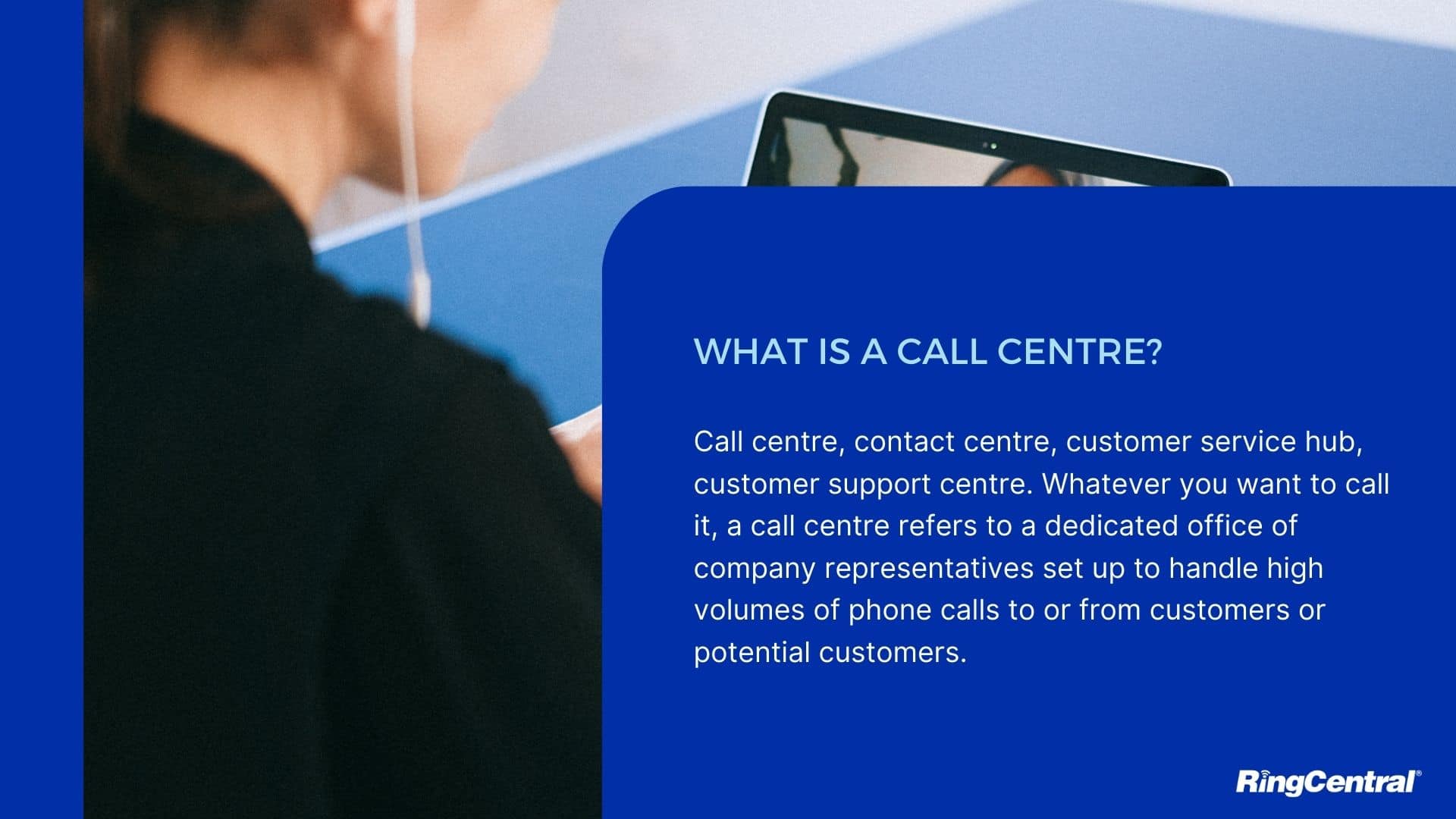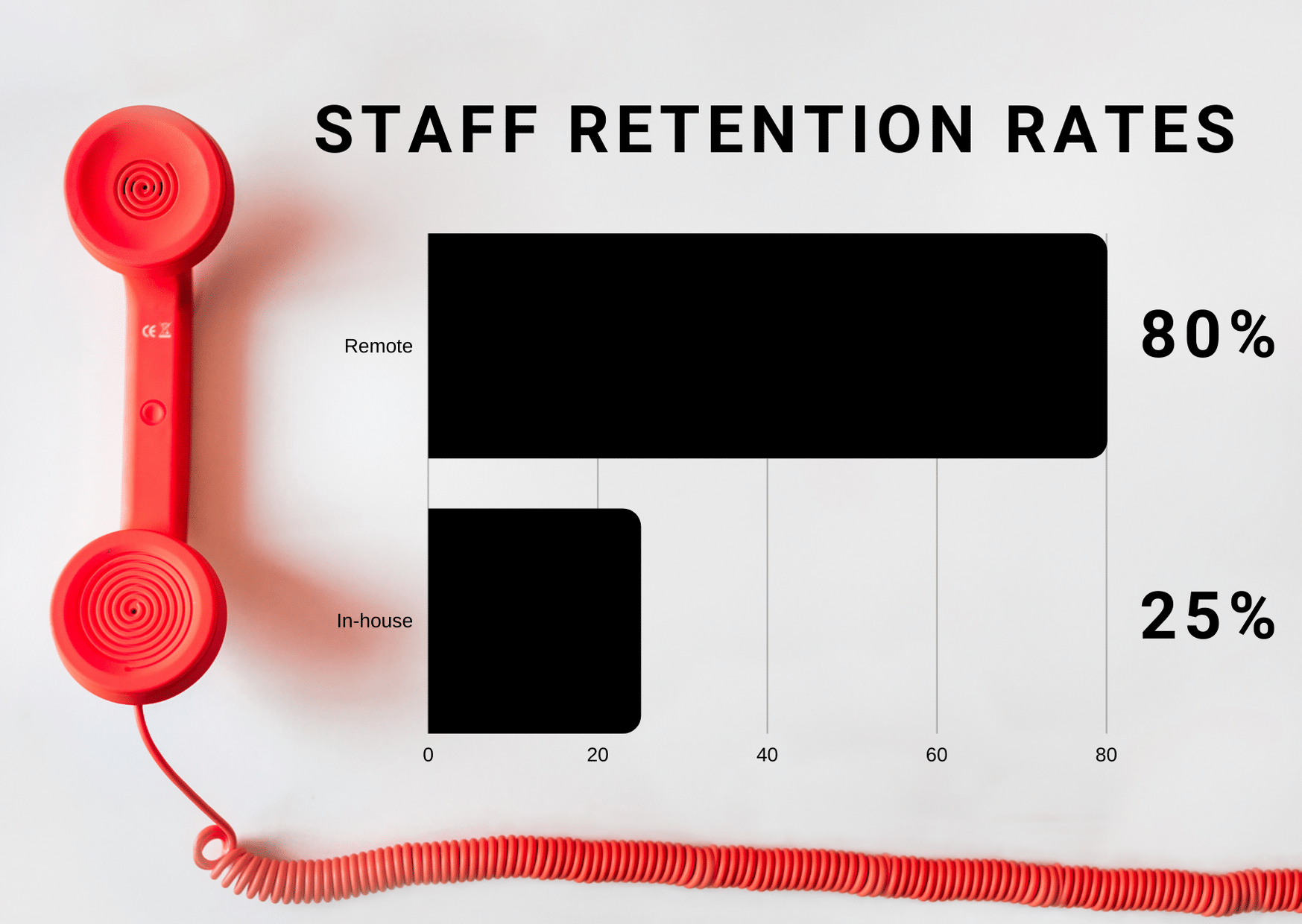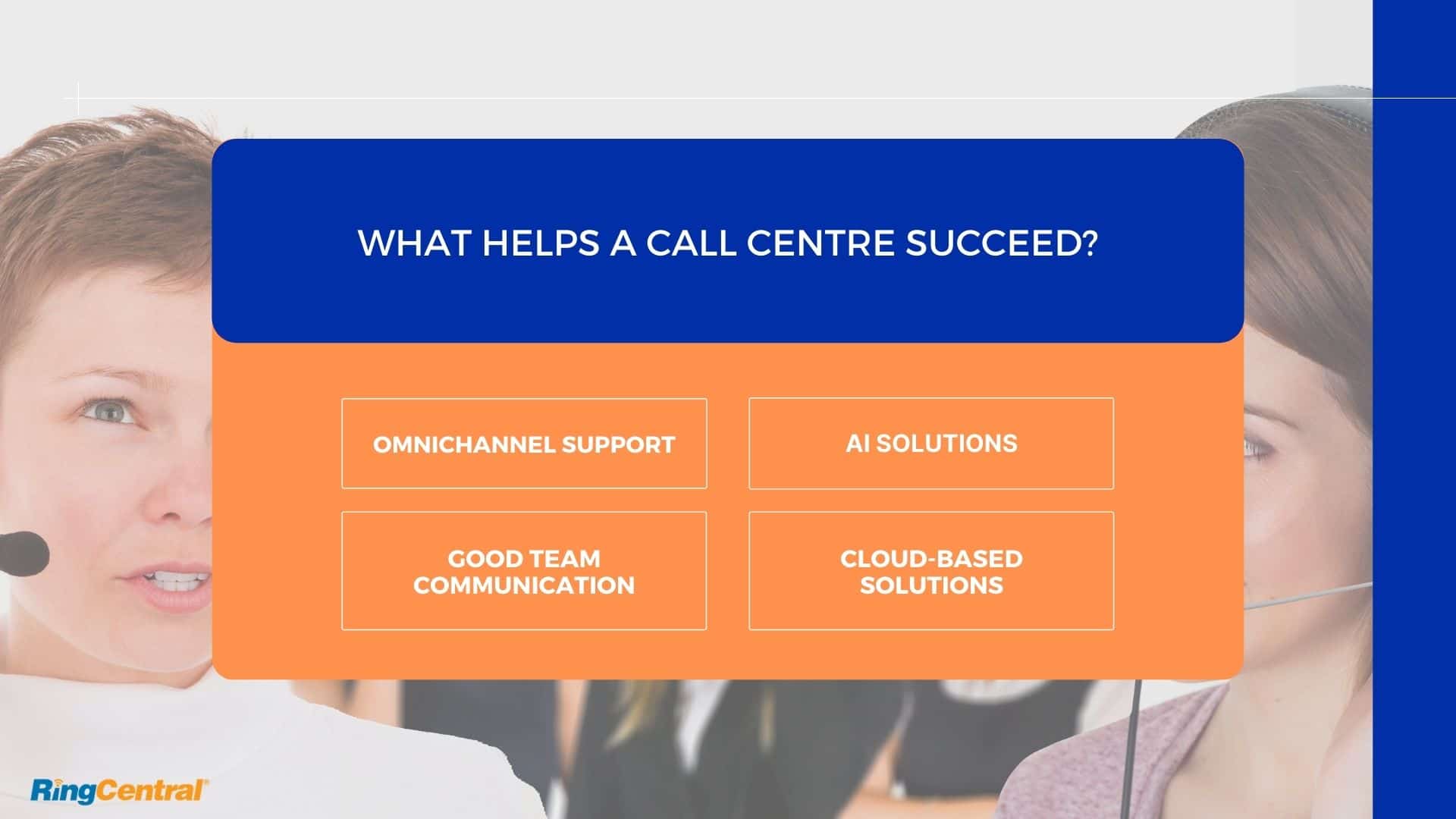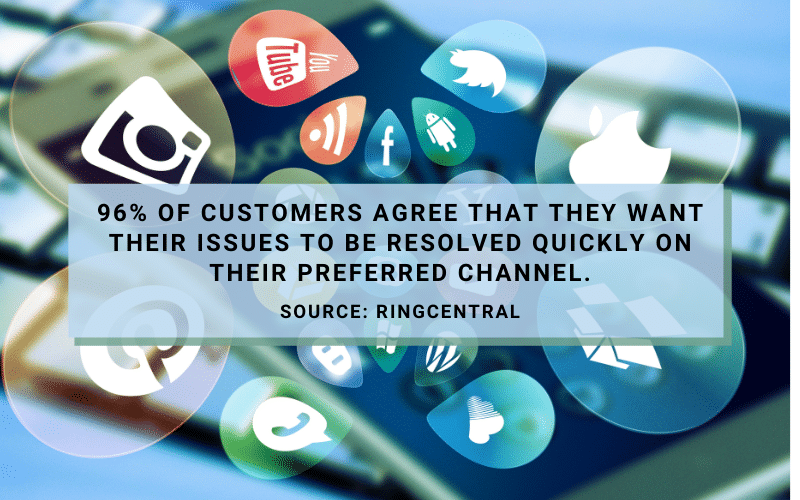Wondering how to start a call centre? No idea where to begin? You’re in the right place.
They’ve been around since the 1960s, but call centres continue to play an integral role in building exceptional customer experience. Picking up the phone is still a trusted way for consumers to resolve issues and get answers to questions. That’s why call volumes remain high.
In today’s age of digital transformation, call centres need to keep up with consumer trends to maintain high levels of customer service. With the rise of cloud-based software solutions, the remote workforce, and artificial intelligence, the customer service landscape is dynamic, exciting, and lucrative.
In this definitive guide, we’re going to give you the full lowdown on setting up a call centre. From outlining your goals, to hiring a team and delivering your call centre training, through to choosing the ideal call centre software; we’ll leave no stone unturned. We’ll even cover off how to handle automatic call distribution (ACD) and best plan your call centre cost structure. So grab a cup of coffee, get comfortable, and let’s get started.
What is a Call Centre?

Call centre, contact centre, customer service hub, customer support centre. Whatever you want to call it, a call centre refers to a dedicated office of company representatives set up to handle high volumes of phone calls to or from customers or potential customers.
Call centres can be organised to serve several business purposes, whether virtual or physical. These can include inbound and outbound calls for sales and marketing, lead generation, customer service, IT support, and more.
Try to think back to the last time you reached out to a customer support team for help. Did you make a phone call? Did you send an email? Or perhaps you sent a message on social media and had a friendly conversation with a chatbot?
Nowadays, most customer support agents and advisors communicate with customers via a range of communication channels, not just through incoming calls. Most businesses allow customers to reach out through email, social media, webchat, and more.
For this reason, the term “contact centre” has become more commonplace than “call centre” in today’s digital landscape. However, phone-based customer support remains one of the most popular support channels, making call centre agent training more important than ever for providing an excellent service.
In fact, a study by Usabilla found that 55% of customers prefer speaking to a human agent on the phone over other contact channels. What’s more, 40% of customers prefer talking to a real person over the phone when it comes to more complicated interactions like payment disputes.

Why Are Call Centres Important?
Did you know that 96% of customers agree customer service plays a leading role in their choice of (and loyalty to) brands? Perhaps you’re even part of that 96%! With this in mind, it’s easy to see why call centres play an integral role in boosting customer satisfaction.
Often call centres to provide a customer’s first — and sometimes only — human interaction with a company. Call centre interactions can build a company’s brand image, solve issues, and even result in a healthier bottom line. What’s more, the data that call centres to gather from customer calls are becoming more and more valuable. These call centre metrics provide consumer insights that allow businesses to make data-driven improvements.
Bad call centre interactions, on the other hand, can cause serious damage to a company’s brand image. An estimated $41 billion is lost by U.S. companies each year following a bad customer experience. In today’s digital age, it’s essential that businesses can meet customer expectations where they are. That means delivering consistent, effective, and personalised customer service at all times.
What are the key features of a good call centre?
Setting up a call centre is a big project, and it involves a lot of time, resources, and patience. However, if you’re ready to put in the hard yards and you know good customer service when you see it, then setting up a call centre can be an accessible goal.
In this guide, we’ll give you a nudge (or two) in the right direction. We’ll explain the fundamental building blocks of a call centre, and the steps involved in setting one up.
You’ll be able to use this guide as a checklist to make sure you don’t miss out on any of the essentials. There’s more to it than merely answering a high number of calls, after all.

[Image by Wokandapix from Pixabay]
1. Establish the Purpose of Your Call Centre.
BBefore you tackle the what, where, who, and how questions, you need to understand why you’re setting up a call centre. Establishing a purpose is the first step in setting up a call centre, and will help you define everything from your call centre cost structure to your training program. Once you’ve got your goals in mind, you’ll be able to plan accordingly and use your objectives to measure results.
So, why do you need a call centre?
Are you running a small business or start-up and want to streamline order processing and payment? Or are you a key member of a large business aiming to increase customer satisfaction rates?
Once you’ve defined your business needs and pinpointed the focus points of your call centre (cold calling, customer support, lead generation, etc.), you can determine some key performance indicators (KPIs) to track your call centre performance metrics. KPIs are quantitative measures of your call centre’s efficiency and quality of service. They’ll help you to make data-driven decisions to boost revenue and improve your customer satisfaction rates.
2. Using Call Centre Metrics to Outline KPIs.
What are good metrics to measure in a call centre? Let’s take a look at some critical call centre metrics that you should follow, which will help you set the right KPIs.
- Average talk time: The amount of time between an agent answering and hanging up the phone.
- Missed and declined calls: Unanswered calls either not picked up or refused by an agent.
- Transfer rate: Rate of calls agents transfer to other departments.
- Abandoned in the queue: Number of customers who call your phone number but hang up while waiting in the queue.
- Average answer speed: The time it takes for a customer to speak to an agent after they’re routed to the right department/person.
- Average handle time: Average length of contact for a customer.
Select KPIs that correspond to your goals and business plan. You don’t need to go overboard tracking your KPIs, just select a few to focus on and measure your productivity and shortcomings against them as your call centre evolves.
Setting goals is a key component to success. If you have clear objectives in mind, then you’ll always have something to work towards. You can also adjust your monitoring strategy to focus on new strengths and weaknesses as you go. Make sure your objectives and targets are clear to your support or sales team (once you find them!) so that everyone is working towards the same goal.

3. Plan your call centre budget.
Running a business goes hand in hand with considerable overheads. According to DMG Consulting, 76% of on-call centre operating budgets are tied to resource-related expenditures.
When you’re setting up a call centre, the costs can add up pretty quickly, from training to cost per seat calculations. It’s a good idea to outline your budget and keep in mind an idea of how much you can realistically spend. This will prevent any hidden costs from taking you by surprise and help you to understand how your call centre will operate.
So what should you consider in your budget?
- The number of employees you’ll need.
- The cost of tools and technology.
- Infrastructure costs (physical or virtual).
Remember that your initial investment in your call centre and the cost of keeping it running will be different. Your initial cost structure will include considerations such as a cost per seat calculation and agent training setup costs and expenses.
Your cost per seat will go a long way to determining your call centre cost structure for an in-person facility, by which we mean there are a range of costs in order to get each agent in place and ready to take calls. The most obvious element is salary, but it should also include costs for equipment such as a desk, headset, phone, and computer, as well as software, training, HR, benefits, and initial hiring costs.
It’s also important to note the difference between an inbound and outbound call centre in terms of how much revenue they generate. An outbound call centre will generate revenue with sales and new customer leads. An inbound call centre will have a weaker link between operation and profit.
Remember, even if your call centre doesn’t bring in revenue itself, it will help to improve customer experience and build your customer relationships. In this sense, a call centre is an investment in the quality of the service or product you’re providing.

[Photo by Kelly Sikkema on Unsplash]
4. Identify what kind of call centre you want to operate.
This goes hand in hand with establishing your goals. Decide the purpose of your call centre, and whether it will be for inbound calls or outbound calls, virtually or on-site.
- Do you want to run an inbound or outbound call centre?
An inbound call centre mainly handles calls initiated by the customer. They come into the call centre, and customer support teams aim to offer a high customer service level.
In an outbound call centre, the agent or employee makes calls to customers for telemarketing, sales, lead generation, and market research.
- Will it be virtual or on-site?
Not so long ago, this wasn’t a choice a customer service provider could make!
Both on-site and virtual call centres have their advantages and disadvantages. You must make the right decision based on your budget, the type of service you want to provide, and the resources at hand. There are some key factors you should consider when deciding between virtual and on-site call centres.
- Costs
Running a business goes hand in hand with considerable overheads. According to DMG Consulting, 76% of on-call centre operating budgets are tied to resource-related expenditures. The costs of technological equipment, office lease space, and maintenance quickly add up. Virtual call centres bypass all of these costs, making them a cost-effective solution for many businesses.
It’s estimated that employers save USD 25,000 for every staff member that works from home. These savings can be spent on cloud-based platforms, increased salaries, and employee benefits. When it comes to costs, going virtual can be a huge money-saver.

- Staff retention
Additionally, virtual call centres allow employers to adjust their staffing levels in times of business growth or contraction, without drastically impacting central operations.

- Operating a global business
Another benefit to setting up a virtual call centre is the ability to hire talented folks from all over the world, while reducing your overhead at the same time. Moreover, virtual call centres provide an efficient means for businesses to provide support in multiple locations, time zones, and languages. Thus enabling them to satisfy a diverse range of customers.
Having your team in an office all together does have its perks, too. It’s easy to pass on the information and resolve issues (employee or customer-related) in person, there’s more opportunity for team camaraderie, and in-person agent training allows for more interactive and personalised sessions.
How do you select the ideal call centre team?
You’ve set up your call centre, invested in great contact centre software, and written a captivating cold calling script. But who’s actually going to provide the customer support?
1. Building a balanced team
Once you know whether your call centre is going to be on-site or virtual, you can start hiring for the best customer support staff to make up your team.
If you’ve decided to hire a remote workforce, you can put out the message in different countries and access candidates from all over the world. This can be advantageous as you’ll be able to choose from a large pool of industry professionals.
If you’ve got an office space, make sure you look for candidates in your area on the right hiring platforms. You can prepare your staff by creating high-quality call centre training courses, but you should also consider the local hiring pool when deciding where to locate your call centre.
Either way, there are some roles that you’re going to need to fill to ensure a cohesive and skilled call centre team. These include:
- Call centre managers for overseeing the call centre and ensuring goals and KPIs are met.
- Team leaders to manage the day-to-day operations and make sure agents stick to the established protocols.
- Representatives (agents) who interact with the customers via phone, they also verify and log customer information.
- Trainers to manage new employees on call centre objectives, processes, and policies.
- Analysts to analyse call centre performance metrics, point out areas for improvement, and provide statistical feedback on activities.
Of course, depending on the size of your call centre, you may need fewer or more employees than this. Once you’ve established your call centre cost structure, you can decide which roles are important in the beginning, and which you can scale as your business grows.
2. The hiring process
When it’s time to hire your call centre staff, there are some questions you’ll need to ask and qualities to look out for. Outline some guidelines for yourself by considering questions like:
- How much experience should they have in a call centre role?
- Should they have flexibility when it comes to scheduling?
- Do they have salary expectations?
Hiring people to work in a call centre requires you to look for specific qualities, namely: great communication skills. Other important traits to look for, among others, include:
- Patient
- Hard-working
- Approachable
- Great creative-problem solving skills
- Organised
- Positive
Remember, your customer service reps can be seen as the face of your brand. They’re the ones your customers have the most contact with. You can instill some of these qualities through the right call centre agent training, but you must hire the right people who can represent your company’s values and are motivated to satisfy customers with great service. Your team will grow, learn, and adapt to new challenges together while ensuring the customer is their priority.

[Image by Tobias Herrmann from Pixabay]
3. Training your staff
According to ICMI, 74% of customer service leaders acknowledge that they aren’t fully empowering their agents to provide the best customer experience. Whether this is in regards to inbound, sales or any other type of call centre agent training, you don’t want to be a part of that statistic! When your agents are empowered with all the training and tools they need, they can deliver better support. That, in turn, leads to improved customer satisfaction rates.
When asked about experiences that would make customers take their business elsewhere, 60% of respondents said unfriendly customer service. 46% said employees’ lack of knowledge. This statistic illustrates the importance of staff training in call centre operations, especially when setting up and putting together your training courses.
It’s important to include training as a part of your call centre set-up process. You can conduct the training sessions in another call centre, online, or on-site if you’re already set-up location-wise. Train employees on any headsets, call scripts, and phone systems that they’ll be using before they start. Here are some best practice tips for effective call centre training:
- Role-playing and fake calls allow staff to test their knowledge and skills in real-life scenarios.
- Encourage new members to shadow more experienced ones.
- Repeat and update training procedures regularly to maintain quality standards.
You might want to consider using a call recording service to track calls, monitor productivity, and perform quality control checks on employees. This will help you to understand if KPIs are being met and improve the overall performance of your team. It’s also a good idea to ask employees for feedback regularly and keep that feedback loop going.
View your call centre as a living organism that’s constantly learning and developing. There are always ways to improve your workforce management, including forecasting, surveys and regularly reviewing your call centre performance metrics, for instance.
4. Staff retention
One difficulty that a remote workforce poses is establishing a sense of team spirit. With a workforce spread over the globe, no centralised office, and on Friday after-work drinks, it might seem difficult to establish a positive workplace culture in your call centre.
However, with internal communication channels, regular video call meetings, and remote agent training, it’s entirely possible to create a cohesive, productive, and motivated remote call centre team. Creating a good team culture will help your call centre employees flourish at work.

What type of call centre infrastructure is needed?
You’ll need the best tools and resources to enable your call centre staff to perform to the best of their ability. As we’ve mentioned before, you must arm your call centre staff with all the tools they need to provide exceptional customer support.
At the bare minimum, you’ll need a high-speed internet connection. There are plenty of other handy digital resources that can strengthen your call centre and improve operations, too.
1. VoIP
Voice over Internet Protocol (VoIP) allows you to initiate calls through a data network as opposed to via an analogue phone line. Why is this beneficial? Using VoIP reduces overhead costs that come with traditional phone lines. It gives your team the flexibility to make and take calls when they want; all they need is a stable internet connection.
2. Help desk
Choosing the right help desk software is crucial to the success of your call centre. If you handle inbound calls, a help desk allows you to keep track of each customer’s interactions with specific members of your support team. It allows your team to operate efficiently and react quickly.
3. CRM solution
Customer Relationship Management (CRM) software is going to provide the base for your client interactions. CRM solutions assist in streamlining sales by tracking your customers along their journey with your business. It could even help inform your call centre sales training, analysing customer journey data to ensure your staff are providing the most efficient and helpful service possible.
72% of consumers agree that when contacting customer service, they expect the agent to ‘know who they are, what they have purchased and had insights into their previous engagement’. Therefore, you must have a system in place to track customer interactions and data effectively.
Customers today demand a personalised experience that caters to their specific needs. So your support team must know about their journey so far. Choose a great CRM solution that will combine your business’ objectives with your customers’ needs.
4. Real-time reporting
An agent dashboard that displays real-time reports and call centre metrics will allow your support staff to improve their performance as they work. What’s more, providing managers with real-time and historical data allows them to analyse performance and make data-driven decisions to improve customer service.
5. Multi-level attendant
Also known as a Multi-Level Interactive Voice Response (IVR), this is a cloud virtual switchboard that gives you more control over how your calls are routed. A Multi-Level IVR allows you to create call-flow configurations with a comprehensive selection of menu options to make sure your customers are always directed to the right place. A cloud-based PBX can also improve efficiency.
It’s important that your IVR is comprehensive, fast, and doesn’t influence customers to abandon their call before they’ve even been put through.
What Helps a Call Centre Succeed?

The consumer landscape is rapidly evolving, and businesses need to keep up with call centre trends to ensure they’re always delivering effective customer service.
1. The importance of omnichannel support.
According to a report by eConsultancy, consumers prefer assistance over the following channels: Phone (61%), email (60%), Live Chat (57%), online knowledge base (51%), “click-to-call” support automation (34%). Today customers are present on a variety of platforms. Businesses must be available on them, too.
Omnichannel support involves being available to your customers on various platforms and delivering seamless customer experience across them all. With an omnichannel support strategy, you’re providing customers with the service they want on the channel they prefer. This is reflected in 96% of customers agreeing that they want their issue to be resolved quickly on their preferred channel.
An omnichannel customer service strategy is essential in the age of digital transformation. Phone support, though still important, is not the be-all-and-end-all of customer support. If you’re not meeting customer expectations by providing consistent support across various channels, then you’re missing out on valuable business opportunities.

2. AI solutions.
According to Microsoft’s State of Global Customer Service report, the global call centre Artificial Intelligence (AI) market is expected to rise to an estimated value of $4.7 billion by 2026. With this in mind, businesses must recognise the value of AI solutions when it comes to operating call centres.
AI is already a popular enhancement tool in many call centres all over the world. AI isn’t about robots becoming sentient and taking over humankind, that’s just the movies. Instead, AI works alongside the human workforce and provides additional support, allowing agents to focus on developing human connections and making better quicker decisions.
Automation can be seen in call centres as:
- Bots that answer simple questions, or direct customers to the right support area.
- Virtual assistants provide additional support to agents.
- Statistical machine learning tools that mine and analyse data to improve operations.
Automate tedious, time-consuming, and repetitive tasks to free up agents to handle more complex customer-centric interactions. It can also be used behind the scenes to help associates to make better, data-driven decisions. What’s more, AI can scale up digital service knowledge capture, and improve the overall quality of your customer service.
One best practice for automation in your call centre is to balance your core service goals with KPIs. This way, you can augment your services with AI to improve efficiency and overall customer experience. It’s about finding the right balance between using human agents and knowing when to deploy AI tools and processes, to provide comprehensive support while saving time, reducing costs, and streamlining processes.

3. Good team communication.
A report by McKinsey found that 97% of employees and executives believe lack of alignment within a team impacts the outcome of a task or project. With this in mind, it’s clear why establishing good team communication practices plays a vital role in a business’s success.
Customer support teams are built on good communication. Support staff pride themselves on and are often hired because of their effective communication skills. However, it’s just as important to nurture communication and collaboration among team members. Whether your customer support team is working in-house or remotely, communication is crucial to a successful and positive work environment.
Lack of good team communication can result in:
- Wasted time
- Lost customers
- Lost employees
When support teams don’t practice effective workplace collaboration, they waste time answering the same simple questions, repeating information, or providing inconsistent answers. This not only affects how customers perceive your product or service but cost your company time and money. What’s more, it can lead to frustrated employees, decreased productivity, and reduced team morale.
Luckily there are plenty of collaboration tools that can help. Whether teams are in on-site or virtual call centres or some combination of the two, collaboration tools allow agents and supervisors to work together in solving problems and assisting customers. Here are some tools you can incorporate when setting up a call centre:
- Create a knowledge base of FAQs that support staff can refer to when they have questions or doubts.
- Use group messaging to ask and answer questions quickly. This eliminates the possibility of single-point failure and creates an open space for employees to be heard.
- Hold regular team meetings or get-togethers (virtual or in-person) to nurture team relationships. Who said coworkers couldn’t be friends?
- Send out feedback surveys asking employees what they think is and isn’t working.
Running a successful call centre relies on a constant flow of information between employees. With a good collaboration system in place, agents can share information, resolve issues, and provide a seamless customer experience.

4. Cloud-based solutions.
A tech trend that is shaping the way forward for contact centres is a shift towards cloud-based call centres. When defining success factors for call centre operation in the age of digital transformation, cloud-based solutions play a vital role in 2020 and beyond. But how difficult is it to create a cloud-based call centre?
A cloud-based contact centre is one that hosts most of its infrastructure online via — you guessed it — the cloud. By using cloud-based call centre technology, businesses can drastically reduce the amount of hardware they use and the associated overhead costs. Software, routing, and networking architecture are all transferred to the cloud.
What are the benefits of a cloud-based call centre?
- No complex hardware setup or maintenance costs.
- Flexibility in business operations as employees can work from home.
- Easy call centre management and easy scalability.
- It provides a disaster recovery solution.
- Information and data are easily shareable.
Opting to create a cloud-based call centre can reduce costs, enhance collaboration, and increase employee satisfaction. What’s more, cloud-based systems are more straightforward to implement than on-site ones. Cloud-based call centre technology can be easily configured to meet client needs, and there are fewer costs involved with updating and maintaining hardware in the office. This makes a cloud-based call centre service incredibly efficient.
There are numerous benefits of using a cloud-based system in a call centre. In today’s digital world, the cloud provides a cost-effective, more efficient alternative to on-site call centres. Moreover, call centre trends indicate that the majority of call centres are planning to make the change to cloud-based solutions in the next few years.

[Photo by Euan Cameron on Unsplash]
Conclusion
Setting up a call centre is a big task that involves time, resources, and careful planning. A great call centre can enhance the customer experience, which is one of the driving factors behind business success and brand loyalty. Customers still seek out ways to talk to human agents, and picking up the phone is still a preferred method of contact.
If you’re establishing a call centre, you need to think about your goals, the tools you use, and the team that’s going to be the face (or voice) of your company. When establishing a call centre, you must stay attuned to digital trends. This allows you to meet customer expectations and continue offering high-quality service and support.
Originally published Oct 07, 2020, updated Jan 16, 2023



